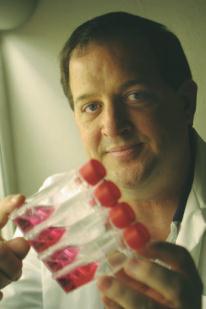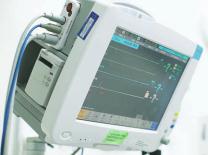



The Harris College Magazine
- Winter 2008 ·
17
16
· Harris College of Nursing & Health Sciences
Kinesiology professor
revolutionizes
P.E.
in
DFW area
O
ver the past six years, Dr. Debbie Rhea (pictured above
on the right), associate professor of kinesiology at
TCU, has committed herself and her time to ensuring
that K-12 students in Fort Worth Independent School District
(FWISD) have a multitude of options for physical activity in a P.E.
setting.
In September, the Dallas Business Journal named Dr. Rhea
a Healthcare Hero for 2007 for her commitment to combating
obesity in Fort Worth schools.
With the help of Dr. Rhea and FWISD PE program director
Georgi Roberts (pictured above on the left), FWISD has received
and implemented fve physical education program grants
from the federal government to aid in revamping the district’s
physical education program for K-12 students.
The grants have been used to obtain new equipment, train
physical education instructors, and develop new activities to
keep students stimulated.
Fitness centers, complete with stationary bikes, elliptical
machines, weights, aerobic steps, physio balls and an audio
system have also been placed in all of the district’s 13 high
schools.
The ftness centers were implemented with the help of
three consecutive grants designated for the high school level,
which have contributed just under a million dollars over a
three-year period to helping high school students stay active.
According to Dr. Rhea, Fort Worth is one of only two
independent school districts in the nation that has received
three grants in a row, and with good reason.
Dr. Rhea’s research indicates that Fort Worth, the third
largest school district inTexas, has some of themost overweight
students in the nation.
In fact on average, 22 percent of elementary students in
America are overweight, while 33 percent of African-American
students, 24 percent of white students and 32 percent of
Hispanic students in FWISD are overweight.
“The statistics are what got us the grants,” Dr. Rhea said.
Also, many FWISD schools are lacking funds and are part of Title
I, a program that aims to “improve the academic achievement
of the disadvantaged,” according to the U.S. Department of
Education.
Out of roughly 80,000 students in FWISD schools in 2007,
about 55,000 of those were eligible to receive free or reduced
meals due to socioeconomic disadvantages.
Generally, lower socioeconomic status, according to Dr.
Rhea, is a potential reason students are overweight, as many
kids don’t have a place to be physically active outside of
school.
On the other hand, Dr. Rhea cites technology as a reason
many kids are uninterested in physical activity. “Kids have
become so enamored with instant stimulation,”Dr. Rhea said.
Because of a constant need for stimulation that is present in
today’s youth, Dr. Rhea had to look for and consider alternative,
unique means of getting kids active and staying healthy.
One of the most creative and consequently most popular
additions to the physical education program is Dance-Dance
Revolution, a game that involves participants dancing on a
pressure-sensitive mat, while following dance steps on a TV
screen.
Also particularly popular are game bikes, exercise bikes
with video simulation of bicycle courses, which change when
students plug in diferent game cartridges.
“We’re making systematic change, and we will keep
progressing,” Dr. Rhea said. The key, she said, is having a long-
term impact on the physical education programs with the
grants provided to FWISD.
Currently, Dr. Rhea is working on grant proposals that
would bring more funding to FWISD, and she is assisting Belton
ISD in obtaining grants for its middle and high school physical
education programs.
“My dream is that we’ll continue to see school districts
want to make changes,” Dr. Rhea said. In her opinion, high
school programs need the most help, as many students at the
high school level are rebellious and unmotivated.
With Dr. Rhea’s enthusiasm and dedication to achieve
success in physical education programs, it is likely that FWISD
and other school districts like Belton will see long-term
change—the kind of change that makes Dr. Rhea a hero. - DTS
I
n fact, 50percent of womendie from
cardiovascular disease compared
with 4 percent who succumb to
breast cancer, according to the National
Institute for Health.
Surprised?
There is good reason to be.
Until recently, doctors and
researchers were mostly in the dark
about heart disease in women. Like the
rest of us, they have clung to the long-
held notion that it mainly aficts men.
Even research, historically, has been
devoted mostly to young and middle-
aged white males, yet fndings are
applied globally to women.
One problem: Men and women
don’t exhibit the same symptoms.
Men tend to develop coronary artery
disease around 50. For women, it’s often
a decade later. Men typically present
with the well-known classics - left arm
radiation, chest pain, palpitations.
Women sometimes experience none of
these. Instead, they report less obvious
signs such as fatigue, shortness of
breath and sleep disturbance.
Why?
That’s the question Dennis Cheek,
Abell-HangerProfessorofGerontological
Nursing, has been asking for more than
two decades, and he thinks he may have
a partial answer.
“Since a woman presents diferently
than a man, her cells must also react
diferently,” he said. “What we’re looking
for is a biological marker, something in
theblood that signals risk for developing
cardiovascular disease.”
Cheek’s search has taken him to
the endothelium, a single layer of cells
that line the inside of the heart and
blood vessels. For years, researchers
believed this organ had little impact on
overall health. Now, they know that it
is active in metabolism and plays a key
role in signaling cardiovascular disease
because of its crucial location between
the blood and vessel walls.
When functioning correctly, the
endothelium produces and releases
nitric oxide (NO), a chemical generated
by the enzyme nitric oxide synthase
(NOS). Nitric oxide relaxes the smooth
muscle surrounding the vessel walls,
thus dilating arteries. As a result, it
reduces blood pressure and aids blood
fow.
But as humans age, endothelial
cells lose function and produce smaller
amounts of NO. Cheek and other
researchers believe this dysfunction
likely marks the beginning of
atherosclerosis and subsequently
heart disease. It is also linked to
diabetes, obesity, hypertension and
high cholesterol.
“Nitric oxide has a protective
efect on the endothelium,” Cheek said.
“Therefore, based on its presence or
absence in endothelial cells circulating
in the blood stream, we could identify
women at risk for heart disease. So the
genetic expression of endothelial nitric
oxide synthase (eNOS mRNA) could be
our biomarker.”
But endothelial cells are difcult to
capture in a blood sample. In a milliliter
of blood, a researcher might collect
only a few – maybe none – making the
sample too diluted to measure.
Cheek’s work has been to develop a
method in vitro to isolate and measure
eNOSmRNA fromcells at a given sample
size. Cheek and student researchers
have used lab-grown female human
vascular umbilical cells and diluted
them into a series of samples, some as
small as a nanogram. Then they amplify
the enzyme using quantitative real-time
polymerase chain reaction, a procedure
that replicates the genetic code.
“Essentially, it works like a copy
machine, duplicating the genetic code
as it goes along, so it can be more
easily measured,” he said. “We can go
from a single sample to a million within
minutes.”
These measurements have helped
Cheek determine a dynamic range
of values of eNOS mRNA in the small
samples - essentially what’s normal -
whichwill give researchers a baseline for
future studies. No matter how diluted a
sample is, Cheek’s fndings will be the
basis for accurate readings.
Next up, testing the technique in a
blood draw. Cheek’s team is approved
to draw blood from patients at John
Peter Smith Hospital in Fort Worth, but
he says they’re not quite ready.
“We’re not going to do it until we
get some other techniques set,” he said.
“But we’ll keep working at it.” - RW
Probing
differences
in heart disease
Heart disease
– not breast cancer –
is the top killer of women in the United States.
McLean Middle School students
playing a scarf relay race.